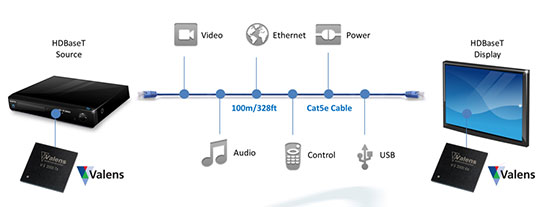InfoComm: HDBaseT Builds a Base in Pro AV
By Tim Kridel
Special to InfoComm International
For a technology that debuted barely four years ago, HDBaseT has amassed an impressive following among pro AV vendors and integrators. Crestron alone, for example, has more than two dozen HDBaseT extenders and other products.
One reason is that HDBaseT is a Swiss Army knife in terms of what it can do.
“The ability to send HDMI video, infrared remote control, RS-232 and Ethernet traffic over the same cable at the same time lures AV integrators to use HDBaseT products,” says Jack Gershfeld, Altinex president. “At this time, there is no comparable single-cable solution that provides the same degree of functionality and off-the-shelf products availability.”

5play over HDBaseT (image courtesy of HDBaseT Alliance)
Another reason for HDBaseT’s popularity is that it uses Cat5e and Cat6 cable, which many enterprises, colleges and other customers already have throughout their facilities. Category cable also is easily terminated in the field.
“HDBaseT is gaining quite a bit of traction in pro AV primarily because it combines the delivery of multiple signals over one standard cable,” says Joseph Cruz, Gefen product manager. “Eliminating extra cabling in the installation environment is almost always considered a benefit.”
That benefit increases in some places. For example, HDBaseT’s ability to carry up to 100 W DC can eliminate the need to hire an electrician for some installations.
But power also is an example of how HDBaseT isn’t without its drawbacks. Electric cables that are too close to Cat5e/6 wiring in walls or ceilings can create interference that affects reliability and performance.
“Drawbacks include environment-dependent operation, susceptibility to electromagnetic fields that creates video blinking and sensitivity to cable quality,” Gershfeld says. “These drawbacks may sometimes create inconsistent performance that requires extensive field troubleshooting for AV integrators.
“Another drawback is that there is currently only one HDBaseT chips manufacturer on the market, so the prices are still relatively high. In most cases, the cost is a prohibitive factor for display manufacturers to add HDBaseT type inputs.”
Power consumption is another consideration.
“The HDBaseT chips are power hungry and require continuous cooling to maintain reliability,” Gershfeld says. “Power consumption in itself creates a significant barrier for incorporating this technology directly into a display as display manufacturers are faced with the green building initiatives and have very low power budget.”
Power consumption is something to consider when deciding where to install HDBaseT devices. For example, receivers should have ample cooling to ensure reliability and maximize their lifespan.
Going the Distance
HDBaseT can support cable runs of up to 100 meters (328 feet). Up to eight passive repeaters can be added to extend that to almost 1 kilometer. Although 100 meters might sound like more than enough for most installations, that’s not always the case.
“People don’t realize how quickly you can use up 100 meters in trying to get around a room,” says Mike Garrido, senior product manager at Christie Digital, which joined the HDBaseT Alliance in April 2014. “It can be used up very quickly when there are turns involved.”
It’s here that another benefit becomes a wild card. HDBaseT enables AV to use a client’s existing category cable, thus saving installation time and freeing up budget for other things. But not every client has detailed, accurate records about where all those cable runs go, so test equipment and educated guesses are necessary to determine how long runs are and the condition of the cable.
At many enterprises, colleges and other organizations, a lot of LAN traffic has shifted to Wi-Fi, which means a facility’s category cable can easily accommodate the addition of HDBaseT-enabled AV traffic. Either way, it’s important to ask the client’s IT department about how their category cable is used. If it needs to be upgraded, or if the cable isn’t in all of the places it needs to be, sometimes the IT department will take on those tasks.
“They love it because it usually means more bandwidth for them,” Garrido says.
The Interoperability Wild Card
The HDBaseT Alliance created a certification program to verify whether products comply with the standard and that it’s interoperable with other certified products. More than 100 products have been certified so far. Two ways to tell are by looking for the HDBaseT logo on the product or its packaging, and by checking the list on their website.
HDBaseT at InfoComm
A lot of new HDBaseT products were announced at InfoComm 2014. Click here for a rundown.
But, one challenge with all standards is that if vendors built only to the spec, there would be few differentiation opportunities besides price. HDBaseT is no exception.
“Gefen looks to provide a few value-added features that should sway any integrator who might be on the fence,” Cruz says. “The Gefen Syner-G that we unveiled at InfoComm, for example, is a software protocol that provides extended display identification data (EDID) management with the ability to upload custom EDIDs, configuration, monitoring and software for updating firmware, all in one convenient implementation that will be standard on all Gefen solutions in 2015.”
Value-added features are why certification comes with caveats.
“HDBaseT products do not guarantee interoperability,” Gershfeld says. “With the introduction of the Vendor ID code by the HDBaseT standard, vendors easily can prevent their product from working with other products.”
“This is very important, as some vendors may have extended capabilities that are not available on other vendor products. A good example would be Altinex’s MUSE product that offers AC power for monitors over Cat6 cable that many other HDBaseT products cannot accommodate,” according to Gershfield.
Vendors also have some flexibility in how they implement the standard.
“Although HDBaseT certification does regulate the implementation of the technology, manufacturers still have the option to accept or decline specific features in the specifications,” Cruz says. “This means that you may not have an across-the-board implementation of HDBaseT in certain extenders, for example. This could potentially cause some confusion in the field.”
So are extended capabilities currently creating interoperability issues? The answer depends on whom you ask.
“Either we’ve been lucky or the people we’re dealing with are sticking to the standard,” Garrido says. “We haven’t come across anything like that.”
“We are seeing some interoperability challenges,” says Randy Riebe, Polycom director of AV integrator business development. “You have to pay really close attention to the manufacturer’s tested equipment compatibility to determine which features they’ve enabled.”
Bottom line — ask vendors about interoperability when deciding which products to recommend for a project. That way, there’s less risk of finger pointing after it’s installed.
“I’d suggest integrators examine all product specifications and features and look for long-range firmware upgrade paths, long-term support of the product and the general reputation of the manufacturer,” Cruz says.
Best Practices
It’s also smart to pay close attention to each vendor’s recommendations for cable management as it applies to transmitters and receivers.
“The cables are incredibly sensitive compared to traditional LAN cable or analog AV cable,” Riebe says. “Be careful about coiling excess wires, wires laid too close together and adjacent power cable interference, [all of] which can create serious issues.”
The right cable also is key.
“Use only Cat5/6 cable that has been certified for HDBaseT operation,” Gershfeld says. “Do not use Cat5/6 patch cables for HDBaseT. They are deadly for HDBaseT signals even at 25 feet.”
To help integrators and others use HDBaseT, the alliance is adding an “Installers Zone” section to its website.
“There will be a lot of best practices, tips, tutorials and white papers,” says Dana Zelitzki, HDBaseT Alliance spokesperson and marketing director for Valens, one of the alliance’s founders. “We also have a forum [that includes] HDBaseT vendor members and a training program for installers.”
Are you using HDBaseT? Share your experiences and tips in InfoComm’s LinkedIn Group.
This column was reprinted with permission from InfoComm International and originally appeared here.





